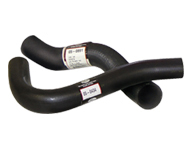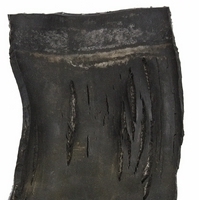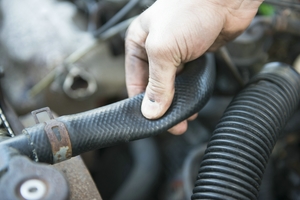Factory Molded to Fit Specific Applications
 |
- Recommend for upper, lower, by-pass, heater and other coolant hose applications
- Heat and ozone resistant cover
- Engineered to resist electrochemical degradation - the leading cause of hose failure
- SAE 20R4 and 20R3 Type EC Class D-1 and D-2 specifications
- Temperature rating: -40° C to 135° C in coolant hose applications
- Caution: Do not use for fuel or oil transfer applications
|
Coolant Hose Fails from the Inside Out
The primary cause of coolant hose failure is an electrochemical attack on the rubber compound in the hose.
This phenomenon is known as electrochemical degradation, or ECD. It occurs because the hose, liquid coolant and engine/radiator fittings form a galvanic cell or “battery”. This creates a chemical reaction which causes micro-cracks to form in the hose tube.
Coolant seeps into these cracks or striations and begins to break down the reinforcement. This leads to hose failure and ultimately roadside breakdowns. |

|
Preventative Maintenance Guide
As there is no way to tell from a simple visual inspection if a hose has internal damage, Gates® recommends that all cooling system hose should be inspected at least once a year for damage from the major hose enemies, including electrochemical degradation (ECD), heat, oil, abrasion, ozone and leakage.
The best way to check coolant hose for the effects of ECD is to squeeze the hose near the clamps or connectors using the following procedure:
1. Make sure the engine is cool.
2. Use fingers and thumb to check for weakness.
3. Squeeze near the clamps and connectors. ECD occurs within two inches of the ends of the hose - not in the middle (See image for correct position).
4. Check for any difference in the feel between the middle and ends of the hose. “Gaps,” or “channels,” can be felt along the length of the hose where it has been weakened by ECD. If the ends are soft and feel mushy, chances are, the hose is under attack by ECD.
|
 |
To avoid the risk of a burst hose and a subsequent breakdown of the cooling system, Gates® engineers recommend replacing the hose immediately.
Download the Cooling System Troubleshooting Manual to learn additional signs which indicate that a hose needs to be replaced.
Coolant Hose Replacement Guide
Pay special attention to hoses that have been in operation for four or more years. Hose failures increase dramatically after that period.
The best advice is to suggest replacement every four years for most vehicles. Vehicles operating under severe conditions may require more frequent replacements.
And remember, to prevent the risk of hose failure Gates® recommends that if you are replacing one hose, that you should change all major cooling system hose at the same time.